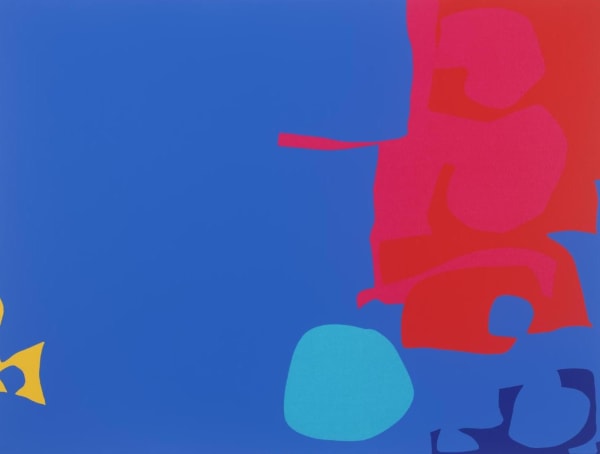Patrick Heron U.K., 1920-1999
Patrick Heron was a British abstract and figurative artist, designer and writer. His early paintings were influenced by Braque, Bonnard, Cézanne and Matisse. Matisse’s use of colour harmonies and notion of creating all areas of a canvas of equal importance, influenced Heron’s work greatly throughout his career in both his early figurative work and later abstract paintings.
Heron turned to abstraction in 1956, follwing his move to Zennor, Cornwall, where he became a member of the St. Ives School, alongside Ben Nicholson, Barbara Hepworth, Peter Lanyon, Joh Wells, Roger Hilton, Bryan Wynter, Terry Frost, Alexander Mackenzie and Wilhelmina Barns-Graham. Heron began to create abstract work inspired by Tachisme and Abstract Expressionism and soon became recognised as one of the leading painters of the St Ives School.
During this period, Heron’s abstract works were varied and his compositions ranged from stripe paintings to more loose settings with soft-edged shapes. He continued to work with lighter palettes and looser brushstrokes later in life. However, all of Heron’s work is notable for its vibrant colour. Light and colour defined much of Heron’s work. In Heron’s notable lecture in 1973, ’The Shape of Colour’, he argued that colour and shape were inseparable from each other, and had stated that his “main interest, in my painting, has always been in colour, space and light”. Alan Bowness had described Heron’s stripe paintings as being ‘stuffed with light and colour and full of a positive life-enhancing quality so free and so refreshing.
Heron had studied at Slade School of Fine Art, London, between 1938 to 1939, and was as highly acclaimed as a writer as well as an artist. He regularly wrote for The New English Weekly and The New Statesman, Nation, Arts New York. and his contribution to art and writing played a key role in spreading modernist ideas in Post-War Britain.
-
 Patrick HeronJanuary 1973 : 8, 1973view more details
Patrick HeronJanuary 1973 : 8, 1973view more details -
 Patrick HeronSmall Yellow: January, 1973view more details
Patrick HeronSmall Yellow: January, 1973view more details -
 Patrick HeronBlues Dovetailed in Yellow : April 1970, 1970view more details
Patrick HeronBlues Dovetailed in Yellow : April 1970, 1970view more details -
 Patrick HeronInterlocking Pink and Vermillion with Blue, 1970view more details
Patrick HeronInterlocking Pink and Vermillion with Blue, 1970view more details -
 Patrick HeronMagenta Disk, Red Edge, 1970view more details
Patrick HeronMagenta Disk, Red Edge, 1970view more details -
 Patrick HeronSix in Light Orange with Red in Yellow, 1970view more details
Patrick HeronSix in Light Orange with Red in Yellow, 1970view more details -
 Patrick HeronThree Reds in Green and Magenta in Blue : April 1970, 1970view more details
Patrick HeronThree Reds in Green and Magenta in Blue : April 1970, 1970view more details
-

Post-War/Modern
Art at the OWO 8 Oct 2024 - 31 Jan 2025Dellasposa Gallery is delighted to present a new exhibition at The OWO Residences by Raffles in London. This historic venue, once the former War Office, now serves as a unique...Read more -

Printed Perspectives
23 Nov 2023 - 5 Jan 2024Dellasposa Gallery is pleased to present Printed Perspectives, an exhibition that bridges the gap between modern and contemporary as it showcases the diverse and innovative printmaking practices of Barbara Hepworth, Lynn Chadwick, Howard Hodgkin, Henry Moore, and Graham Sutherland. This curated collection invites you to witness the evolution of printmaking across movements, offering a unique lens into the visions of these influential artists.Read more -

Modern Mavericks
5 - 21 Sep 2019Dellasposa Gallery is pleased to present Modern Mavericks. The exhibition explores the work of Pablo Picasso and Henri Matisse and the indelible mark they left upon British modernism through the artists Patrick Heron, Patrick Caulfield, and William Scott.Read more
Pablo Picasso and Henri Matisse stand at the heart of modernism as they cross the frontier between figurative art and abstraction in their unique quests for new aesthetic expression. The exhibition traces the ways the British artists engaged with a much deeper and more varied appreciation of the modern masters than is widely understood, by drawing a comparison with Picasso's metamorphosis of style and Matisse's use of colour and pure line.
Formed between dialogue of European pictorial tradition and culture of modernity, the British artists were inspired by the avant-garde while reinterpreting visual language to express their own progressive form of abstraction. Among the British artists for whom the work of Picasso and Matisse proved significant stimulus, Terry Frost, Patrick Heron, Patrick Caulfield, and William Scott - all associated with St Ives in Cornwall - emerged as a dynamic force.
Picasso was a maverick in every sense - his evolution of subject and style was never absorbed by one influence. While he pioneered many of the most significant movements in the twentieth, his aesthetic and profound sensibility was so unique and distinctive that it still remains triumphant today. Yet without Picasso - or the equally brilliant Matisse - the story of British modernism that follows would have been quite different.
Modern Mavericks presents a collection of original limited edition prints, works on paper, and paintings. The exhibition is curated with the view that works of art are influenced not only by more extensive cultural and philosophical developments but also by idiosyncratic qualities and disposition of the artist whose unique aesthetic eye informs what they create.











